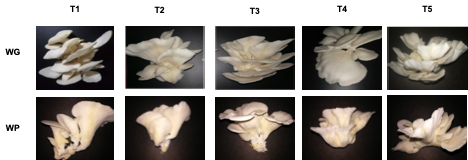 |
|
The objective of this study is to evaluate the potential of agave bagasse supplemented with urea for use as an alternative substrate in the cultivation of a wild fungus isolated from Agave salmiana (A. salmiana), determining the biological efficiency, production rate, morphological characteristics and nutritional. The fungus was identified by molecular methods amplifying the ITS region and subsequently cultivated on A. salmiana bagasse supplemented with urea (0.77, 0.95, 1.14, 1.32 and 1.5% of total nitrogen (TN)). For the cultivation of the fungus, two types of inoculum were used: in the form of grain and in the form of granules. The fungus was identified as Pleurotus djamor. A biological efficiency (BE) of 70% was obtained in the sample inoculated with grain at 1.32% TN, at 1.5% it produced malformations in the fruiting bodies. Chemical analysis of the sporocarps shows a crude protein content of 15-26%. This is the first report of the isolation of P. djamor from A. salmiana as an atypical substrate, which represents an opportunity for its commercialization and the bagasse, due to its chemical composition and being supplemented with urea, allows the growth of the fungus without alter its nutritional composition of this genus.
Keywords: basidiomycete fungus, maguey, nutritional composition, phylogenetic tree, production parameters.
|
|
 |

